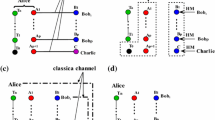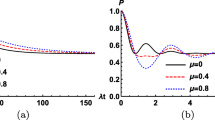Abstract
In this paper, two conclusive multiparty quantum state sharing protocols in amplitude damping channel are proposed that, respectively share an arbitrary unknown single-qubit state and single-qutrit state. To achieve this aim, the detailed processes of sharing pure entangled quantum states as quantum channel in amplitude damping channel via entanglement compensation is proposed first. Then, based on the pure entangled quantum state shared among dealer and all agents, the dealer’s secret quantum information, i.e., single-qubit state (or single-qutrit state) is split in such a way that it can be probabilistically reconstructed through introducing an auxiliary qubit (or qutrit) and performing appropriate operations provided that all the receivers collaborate together. Through the analysis, we have found that whether in single-qubit or single-qutrit state sharing protocols, the successful probability of receiver recovering the secret quantum information is only determined by the small one among the absolute values of the coefficients characterizing the quantum channel. In addition, through the analysis, it proves that the conclusive multiparty single-qutrit state sharing has higher efficiency than single-qubit state sharing under the same amplitude damping strength.




Similar content being viewed by others
References
Bennett, C.H., Brassard, G., Crepeau, C., et al.: Teleporting an unknown quantum state via dual classical and Einstein-Podolsky-Rosen channels. Phys. Rev. Lett. 70, 1895 (1993)
Sun, Y., Gao, F., Yuan, Z., et al.: Splitting quantum secret without the assistance of entanglements. Quantum Inf. Process. 11(6), 1741–1750 (2012)
Debashis, S., Prasanta, K.P.: N-qubit quantum teleportation, information splitting and superdense coding through the composite GHZ-Bell channel. Quantum Inf. Process. 11(2), 615–628 (2012)
Bennett C.H., Brassard G.: Quantum cryptography Public key distribution and coin tossing. In: Proceedings of the IEEE International Conference on Computers, Systems and Signal Processing, Bangalore, India, pp. 175–179. IEEE, New York (1984).
Ekert, A.K.: Quantum cryptography based on Bell’s theorem. Phys. Rev. Lett. 67, 661 (1991)
Vahid, K., Alireza, B., Saber, B.: Quantum key distribution for d-level systems with generalized Bell states. Phys. Rev. A 65(5), 052331 (2002)
Yang, K., Huang, L., Yang, W., et al.: Quantum teleportation via GHZ-like state. Int. J. Theor. Phys. 48, 516–521 (2009)
Zhou, R.G., Xu, R.Q., Ian, H.: Bidirectional quantum teleportation by using six-qubit cluster state. IEEE Access 7, 44269–44275 (2019)
Hillery, M., Bužek, V., Berthiaume, A.: Quantum secret sharing. Phys. Rev. A 59, 1829 (1999)
Gao, Z.K., Li, T., Li, Z.H.: Deterministic measurement-device-independent quantum secret sharing. Sci. China-Phys. Mech. Astron. 63, 120311 (2020)
Hu, W.W., Zhou, R.G., Li, X., et al.: A novel dynamic quantum secret sharing in high-dimensional quantum system. Quantum Inf. Process. 20(5), 159 (2021)
Boström, K., Felbinger, T.: Deterministic secure direct communication using entanglement. Phys. Rev. Lett. 89, 187902 (2002)
Xu, G., Xiao, K., Li, Z.P., et al.: Controlled secure direct communication protocol via the three-qubit partially entangled set of states. Cmc-Comput. Mater. Con. 58(3), 809–827 (2019)
Jakobi, M., Simon, C., Gisin, N., et al.: Practical private database queries based on a quantum-key-distribution protocol. Phys. Rev. A 83(2), 022301 (2011)
Yang, Y.G., Liu, Z.C., Chen, X.B., et al.: Robust QKD-based private database queries based on alternative sequences of single-qubit measurements. Sci. China-Phys. Mech. Astron. 60(12), 120311 (2017)
Zhou, R.G., Hua, Y.: Quantum private query using W state. Int. J. Theor. Phys. 60(7), 2531–2542 (2021)
Symul, T., Bowen, W.P., et al.: Tripartite quantum state sharing. Phys. Rev. Lett. 92, 177903 (2004)
Li, Y.M., Zhang, K.S., Peng, K.C.: Multiparty secret sharing of quantum information based on entanglement swapping. Phys. Lett. A 324, 420–424 (2004)
Deng, F.G., Li, X.H., Li, C.Y., et al.: Multiparty quantum-state sharing of an arbitrary two-particle state with Einstein-Podolsky-Rosen pairs. Phys. Rev. A. 72(4), 044301 (2005)
Li, X.H., Zhou, P., Li, C.Y., et al.: Efficient symmetric multiparty quantum state sharing of an arbitrary m-qubit state. J. Phys. B 39(8), 1795–1983 (2006)
Deng, F.G., Li, X.H., Li, C.Y., et al.: Multiparty quantum secret splitting and quantum state sharing. Phys. Lett. A 354, 190–195 (2006)
Gordon, G., Rigolin, G.: Generalized quantum-state sharing. Phys. Rev. A 73(6), 062316 (2006)
Wang, Z.Y., Liu, Y.M., Wang, D., et al.: Generalized quantum state sharing of arbitrary unknown two-qubit state. Opt. Commun. 276(2), 322–326 (2007)
Man, Z.X., Xia, Y.J., An, N.B.: Quantum state sharing of an arbitrary multiqubit state using nonmaximally entangled GHZ states. Eur. Phys. J. D 42, 333–340 (2007)
Wang, Z.Y., Yuan, H., Shi, S.H., Zhang, Z.J.: Three-party qutrit-state sharing. Eur. Phys. J. D 41(2), 371–375 (2007)
Liu, J., Liu, Y.M., Zhang, Z.J.: Generalized multiparty quantum single-qutrit-state sharing. Int. J. Theor. Phys. 47(9), 2353–2362 (2008)
Wang, T.J., Zhou, H.Y., Deng, F.G.: Quantum state sharing of an arbitrary m-qudit state with two-qudit entanglements and generalized Bell-state measurements. Phys. A 387(18), 4716–4722 (2008)
Yuan, H., Liu, Y.M., Han, L.F., Zhang, Z.J.: Tripartite arbitrary two-qutrit quantum state sharing. Commun. Theor. Phys. 49(5), 1191–1194 (2008)
Wei, Y., Jiang, M.: Multi-qudit state sharing via various high-dimensional Bell channels. Quantum Inf. Process. 14, 1091 (2015)
Qin, H., Tso, R., Dai, Y.W.: Multi-dimensional quantum state sharing based on quantum Fourier transform. Quantum Inf. Process. 17, 48 (2018)
Qin, H.W., Tso, R.L.: Threshold quantum state sharing based on entanglement swapping. Quantum Inf. Process. 17, 142 (2018)
Lee, S.M., Lee, S.W., Jeong, H., Park, H.S.: Quantum teleportation of shared quantum secret. Phys. Rev. Letts. 124, 060501 (2020)
Ma, L.Y.: Two-qubit quantum state sharing protocol based on Bell state. Int. J. Theor. Phys. 59, 1844–1853 (2020)
Yu, T., Eberly, J.H.: Finite-time disentanglement via spontaneous emission. Phys. Rev. Letts. 93(14), 140404 (2004)
Nielsen, M.A., Chuang, I.L.: Quantum Computation and Quantum Information. Cambridge University, Cambridge, England (2010)
Fonseca, A.: High-dimensional quantum teleportation under noisy environments. Phys. Rev. A 100, 062311 (2019)
Lee, J.C., Jeong, Y.C., Kim, Y.S., Kim, Y.H.: Experimental demonstration of decoherence suppression via quantum measurement reversal. Opt. Express 19(17), 16309–16316 (2011)
Huang, J.: The protection of qudit states by weak measurement. Acta Physica Sinica 66(10), 010301 (2017)
Li, W.J., Zhao, Y.H., Leng, Y.: Protecting high-dimensional quantum entanglement from the amplitude phase decoherence sources by weak measurement and reversal. Laser Phys. 29(6), 065204 (2019)
Pramanik, T., Majumdar, A.S.: Improving the fidelity of teleportation through noisy channels using weak measurement. Phys. Lett. A 377, 3209–3215 (2013)
Bai, C.M., Li, Z.H., Li, Y.M.: Improving fidelity of quantum secret sharing in noisy environments. Eur. Phys. J. D 72(7), 126 (2018)
Bai, C.M., Li, J., Zhang, S.J., Liu, L.: Improving fidelity of quantum secret sharing by weak measurement. Laser Phys. Lett. 17(2), 025205 (2020)
Acknowledgements
This work is supported by the National Natural Science Foundation of China under Grant No. 6217070290 and Shanghai Science and Technology Project under Grant No. 21JC1402800 and 20040501500; the Hunan Provincial Natural Science Foundation of China under Grant No. 2020JJ4557.
Author information
Authors and Affiliations
Corresponding author
Ethics declarations
Conflict of interest
No conflict of interest exists in the submission of this manuscript.
Consent to publication
The manuscript is approved by all authors for publication.
Additional information
Publisher's Note
Springer Nature remains neutral with regard to jurisdictional claims in published maps and institutional affiliations.
Appendices
Appendix 1: Proof of Theorem 1
Theorem 1
On condition that Alice prepares two-qubit maximal entangled Bell state \(\left| {B_{0,0} } \right\rangle = {1 \mathord{\left/ {\vphantom {1 {\sqrt 2 }}} \right. \kern-0pt} {\sqrt 2 }}\left( {\left| {00} \right\rangle + \left| {11} \right\rangle } \right)_{{{\text{A}}_{1} {\text{A}}_{2} }}\), when she measures qubit A2 in Z-basis and obtains the result \(\left| 0 \right\rangle\) in Step 1.4 of Sect. 3.1, Alice shares three-qubit pure entangled state \(\left| \Phi \right\rangle_{{{\text{A}}_{{1}} {\text{BC}}}} = {1 \mathord{\left/ {\vphantom {1 {\sqrt {1 + \left( {1 - D} \right)^{3} } }}} \right. \kern-0pt} {\sqrt {1 + \left( {1 - D} \right)^{3} } }}\left( {\left| {000} \right\rangle + \sqrt {\left( {1 - D} \right)^{3} } \left| {111} \right\rangle } \right)_{{{\text{A}}_{{1}} {\text{BC}}}}\) with Bob and Charlie.
Proof 1
When Alice sends the qubit A2 to Bob via amplitude damping channel, the density matrix of two-qubit A1 and A2 can be expressed as:
where \(\rho = \left| {B_{0,0} } \right\rangle_{{{\text{A}}_{1} {\text{A}}_{2} }} \left\langle {B_{0,0} } \right|\), and \(\rho_{b}\) is the density matrix of qubits (A1, A2) when Bob receives the qubit A2.
When Bob performs the CNOT operation on qubit A2 and ancillary qubit \(\left| 0 \right\rangle_{B}\), the density matrix of three qubits (A1, A2, B) is written as:
Then, Bob further sends qubit A2 to Charlie via amplitude damping channel. When Charlie receives the qubit A2, the density matrix of three qubits (A1, A2, B) evolves into:
When Charlie performs the CNOT operation on qubit A2 and ancillary qubit \(\left| 0 \right\rangle_{C}\), the density matrix of four qubit (A1, A2, B, C) is written as:
Then, Charlie sends qubit A2 to Alice via amplitude damping channel. When Alice receives the qubit A2, the density matrix of four qubit (A1, A2, B, C) evolves into:
Final, Alice first performs the CNOT operation on two qubits (A1, A2), the density matrix of four qubit (A1, A2, B, C) evolves into:
Hence, when Alice measures qubit A2 in Z-basis \(\left\{ {\left| 0 \right\rangle ,\left| 1 \right\rangle } \right\}\), it would disentangle the qubit A2 with other three qubits (A1, B, C). If she obtains the result \(\left| 0 \right\rangle\), the density matrix of three qubits (A1, B, C) is collapsed to:
After renormalization of above Eq. (A7), Alice shares the pure entangled state with two agents Bob and Charlie written as:
Appendix 2: Proof of Theorem 2
Theorem 2
On condition that Alice prepares the generalized Bell state \(\left| {GB_{0,0} } \right\rangle = {1 \mathord{\left/ {\vphantom {1 {\sqrt 3 }}} \right. \kern-0pt} {\sqrt 3 }}\left( {\left| {00} \right\rangle + \left| {11} \right\rangle + \left| {22} \right\rangle } \right)_{{{\text{A}}_{1} {\text{A}}_{2} }}\), when she measures qutrit A2 in Z-basis and obtains the result \(\left| 0 \right\rangle\) in Step 1.4 of Sect. 4.1, Alice shares the pure entangled state \(\left| \Psi \right\rangle_{{{\text{A}}_{{1}} {\text{BC}}}} = {1 \mathord{\left/ {\vphantom {1 {\sqrt {1 + 2\left( {1 - D} \right)^{3} } }}} \right. \kern-0pt} {\sqrt {1 + 2\left( {1 - D} \right)^{3} } }}\left( {\left| {000} \right\rangle + \sqrt {\left( {1 - D} \right)^{3} } \left| {111} \right\rangle + \sqrt {\left( {1 - D} \right)^{3} } \left| {222} \right\rangle } \right)_{{{\text{A}}_{{1}} {\text{BC}}}}\) with Bob and Charlie.
Proof 2
When Alice sends the qutrit A2 to Bob via amplitude damping channel, the density matrix of qutrits (A1, A2) can be expressed as:
where \(\rho = \left| {GB_{0,0} } \right\rangle_{{{\text{A}}_{1} {\text{A}}_{2} }} \left\langle {GB_{0,0} } \right|\), and \(\rho_{b}\) is the density matrix of qutrits (A1, A2) when Bob receives the qutrit A2.
When Bob performs the GCNOT operation on qutrit A2 and ancillary qutrit \(\left| 0 \right\rangle_{{\text{B}}}\), the density matrix of three qutrits (A1, A2, B) is written as:
Then, Bob sends qutrit A2 to Charlie via amplitude damping channel. When Charlie receives the qutrit A2, the density matrix of three qutrits (A1, A2, B) evolves into:
When Charlie performs the GCNOT operation on qutrit A2 and ancillary qutrit \(\left| 0 \right\rangle_{C}\), the density matrix of four qutrits (A1, A2, B, C) is written as:
Then, Charlie sends qutrit A2 to Alice via amplitude damping channel. When Alice receives the qutrit A2, the density matrix of four qutrit (A1, A2, B, C) evolves into:
Final, Alice first performs the IGCNOT operation on two qutrits (A1, A2), the density matrix of four qutrit (A1, A2, B, C) evolves into:
Hence, when Alice measures qutrit A2 in Z-basis \(\left\{ {\left| 0 \right\rangle ,\left| 1 \right\rangle ,\left| 2 \right\rangle } \right\}\), it would disentangle the qutrit A2 with other three qutrits (A1, B, C). If she obtains the result \(\left| 0 \right\rangle\), the density matrix of three qutrits (A1, B, C) can be expressed as:
After renormalization of above Eq. (A15), Alice now shares the pure entangled state with two agents Bob and Charlie written as:
Rights and permissions
About this article
Cite this article
Hu, W.W., Zhou, RG. & Luo, G.F. Conclusive multiparty quantum state sharing in amplitude-damping channel. Quantum Inf Process 21, 3 (2022). https://doi.org/10.1007/s11128-021-03333-4
Received:
Accepted:
Published:
DOI: https://doi.org/10.1007/s11128-021-03333-4




